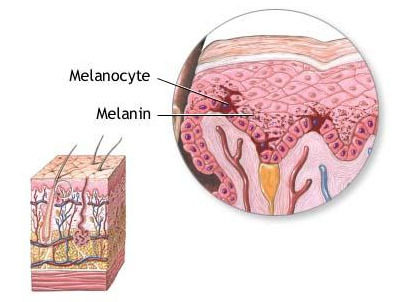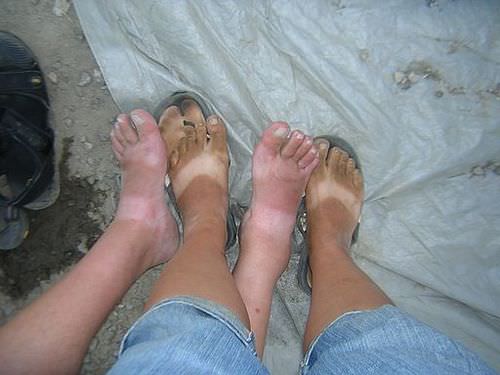皮肤颜色的变异
章节大纲
-
Viva la Différence!
::维瓦·拉·迪凡伦万岁!The people in this photo exhibit some of the variation in skin color that characterizes the human . Human skin color shows relatively great diversity around the world. Although terms such as "black," "red," "yellow," and "white" are often used to describe human skin color, people don't actually have skin of these colors. Some people — including many Africans, Melanesians, and Australian Aborigines — have skin that is very dark brown. Some Northern Europeans, in contrast, have skin that is closer to pale yellowish pink. The use of skin color as an arbitrarily chosen trait to classify people into races has no biological basis, but asking why such variation in human skin color exists is a valid biological question. The geographic distribution of skin color is a good place to start in answering this question, because it reflects the primary environmental stress that has resulted in skin color variation: ultraviolet (UV) light.
::照片中的人展示了人类的肤色差异。人类的肤色显示全世界相对而言差异很大。尽管“黑”、“红”、“黄”、“黄”和“白”等术语常常被用来描述人类的肤色,但人们实际上没有这些肤色的皮肤。有些人——包括许多非洲人、美拉尼西亚人和澳大利亚原住民——的皮肤非常暗淡。相比之下,一些北欧人的皮肤更接近黄色粉色。使用肤色作为任意选择的特征来将人分类为种族没有生物依据,但问为什么人类肤色的这种差异是一个有效的生物问题。肤色的地理分布是回答这一问题的一个很好的起点,因为它反映了导致肤色变化的主要环境压力:紫外线(UV)光。Geographic Distribution of Skin Color
::皮肤色地理分布People from regions of the world at or near the equator generally have darker skin than people who live in regions farther from the equator, because variation in human skin color is closely related to geographic variation in solar radiation. Until human increased dramatically over the past several hundred years, human skin color showed a clinal (gradual) distribution. Dark skin tended to be concentrated near the equator where solar radiation was most intense, and increasingly lighter skin, on average, was found farther north or south of the equator as the intensity of solar radiation diminished. This distribution is shown on the map . The map was created in 1896 and better reflects the correlation between solar radiation and skin color than the present distribution does . The present distribution is less clear-cut, because of the migration of people around the world in the recent past.
::与居住在赤道以外地区的人相比,来自赤道或其附近世界各区域的人的皮肤一般更暗,因为人类肤色的变异与太阳辐射的地理变化密切相关;除非人类在过去几百年中急剧增加,否则人类肤色的分布呈现出阴道(渐变)的分布;由于太阳辐射强度降低,赤道以北或以南较浅的皮肤一般都集中在赤道附近,因为太阳辐射强度降低;地图上显示这种分布。地图是1896年绘制的,比目前的分布更好地反映太阳辐射和皮肤的相互关系。目前分布不那么清晰,因为最近世界各地的人口迁移。This map of human skin color distribution applies to the late 1800s.
::此人类肤色分布图适用于1800年代末期。Another way of showing the distribution of skin color is represented by the graph The graph shows how skin reflectance varies with latitude. Skin reflectance is a quantitative measure of skin color. Darker skin absorbs more light and reflects less light, so it has lower reflectance than lighter skin, which absorbs less light and reflects more. At the equator (0 degrees latitude), the percent of light reflected by the skin is lowest. This shows that skin is darkest at the equator. As latitude increases, the amount of light reflected by the skin increases. This shows that skin gets lighter farther from the equator.
::显示皮肤分布的另一种方式是图示 图表 图表 图表 显示皮肤反射与纬度不同 。 皮肤反射是皮肤颜色的定量测量 。 皮肤反射是皮肤颜色的定量测量 。 更暗的皮肤吸收更多光, 反映较少的光, 反映较少的光, 反映更多 。 在赤道( 0 度纬度) 中, 皮肤反射的光百分比最低 。 这显示赤道的皮肤最暗 。 随着纬度的增加, 皮肤增加的光量也反映出来。 这显示皮肤比赤道更轻。This graph shows how skin color (as measured by light reflectance) changes with latitude. The values in the graph represent indigenous populations, so the correlation between skin reflectance and latitude is stronger than it would be today now that migration has impacted the geographic distribution of people by skin color.
::此图显示皮肤颜色( 按光反射度衡量 ) 如何随纬度变化。 图形中的数值代表了土著人口, 因此皮肤反射和纬度之间的关联性比现在更强, 如今移民已经通过肤色影响着人口的地理分布。Physiology of Human Skin Color
::人类皮肤肤色生理生理学Human skin color is determined mainly by a pigment called melanin , although flowing close to the skin and the presence of other pigments in the skin play a small role in skin color, as well. All people have melanin in their skin, regardless of how dark or light their skin is. There are, however, two different forms of melanin:
::人类的肤色主要由一种称为美兰素的色素决定,尽管在皮肤附近流动,皮肤上其他色素的存在在皮肤颜色方面也作用不大。 所有人都在皮肤上含有美兰素,无论皮肤有多黑或浅。 然而,有两种不同的美兰素形式:-
One form of melanin, called pheomelanin, is reddish yellow in color. This is the main form of melanin produced by people with light skin.
::一种叫的梅兰宁 是一种红色黄色的黄色, 这是皮膚浅的人生产的主要梅兰宁形式。 -
The other form of melanin, called eumelanin, is dark brown in color, and it's the main form of melanin produced by people with dark skin.
::另一种叫埃梅拉宁的梅兰宁 彩色是深褐色 这是黑皮肤人生产的主要梅兰宁
The difference in type of melanin is one reason why people vary in their skin color. Another reason for skin color variation is a difference in the amount of melanin produced in the skin. The latter reason explains most of the variation in skin color.
::美兰素种类的差异是人们肤色不同的原因之一,而肤色差异的另一个原因是皮肤产生的美兰素数量的差异。 后一种原因解释了大部分肤色差异的原因。Synthesis and Function of Melanin
::Melanin 合成和函数The skin consists of multiple layers, as shown in the diagram . Special skin called melanocytes are responsible for melanin production. They are located at the bottom of the outer layer of skin, which is called the epidermis . The number of melanocytes varies from one part of the body to another, but the number does not generally vary significantly among people, even those with different skin colors. Within melanocytes, melanin is actually synthesized in small called melanosomes. These organelles function to produce, store, and transport melanin. Differences in the number and size of melanosomes explain most of the variation in skin color.
::皮肤由多层组成,如图所示。特殊皮肤,叫做梅兰诺氏菌,是生产梅兰素的原因。它们位于皮肤外层的底部,即皮皮层。青蒿素的数量因身体的某一部分而异,但人与人之间,甚至肤色不同的人之间,其数量一般没有很大差异。在青蒿素中,梅兰宁实际上是以小的所谓黑素合成的。这些有机物的作用是生产、储存和运输美兰素。黑兰素的数量和大小差异解释了大部分肤色的变化。This diagram of the skin focuses on melanocytes and melanin.
::此皮肤图以地中海和梅拉宁为焦点。As melanosomes become full of melanin, they move into slender, arm-like extensions of the melanocytes. From there, the melanosomes are transferred to keratinocytes. Keratinocytes are the predominant cell type in the epidermis, and their function is to protect the lower layer of skin. Melanosomes cover the upper part of the keratinocytes, where they prevent damage from UV light by absorbing it. In general, the more melanin there is in the skin, the more UV light that can be absorbed.
::随着美兰素的成形,它们会移动成细状的,与甲状腺素相似的手臂延伸体。从那里,黑素被转移至小鼠细胞中。Keratino细胞是上皮细胞中主要的细胞类型,其功能是保护下层的皮肤。美拉诺细胞覆盖了甲状腺素的上部部分,通过吸收它们防止紫外线光的损害。一般而言,皮肤中的黑素越多,紫外线光就越能被吸收。Genetics of Skin Color
::皮肤色遗传基因Both the type and amount of melanin produced in the skin are controlled by several genes with multiple . Some of the genes have major effects, while others have minor effects. Different have different frequencies of the alleles. The combined effects of the alleles bring about the complex, continuous variation in skin color in the human species worldwide.
::皮肤中生产的梅拉宁的类型和数量都由多种基因所控制。有些基因具有重大效果,而另一些则有轻微效果。不同基因具有不同频率的异形。异形的综合效应导致全世界人类肤色的复杂和持续变化。Evolution of Skin Color
::皮肤颜色的演变Human skin color has varied in our evolutionary past, as well as geographically. As early humans moved from tropical forests into savanna habitats , a major challenge was keeping cool. They evolved more sweat glands on the skin as an adaptation to the stress of heat. Sweat cools the body when it evaporates from the skin. For this to be effective, the skin must be relatively hairless, so the amount of body hair decreased. However, the loss of body hair created another problem: it exposed the skin to strong UV radiation , which resulted in for darker skin to absorb the radiation and protect the body.
::在我们进化的过去和地理上,人类的肤色各不相同。随着早期人类从热带森林迁移到热带稀树草原栖息地,一个重大挑战是保持凉爽。它们随着热应力的适应,在皮肤上进化出更多的汗腺。当皮肤蒸发时,汗水会使身体冷却。要有效,皮肤必须相对无毛,这样身体毛发的数量就会减少。然而,人体毛发的丧失又造成了另一个问题:它使皮肤暴露在强烈的紫外线辐射之下,导致更深的皮肤吸收辐射和保护身体。Dark skin evolved about 1.2 million years ago in Africa and is the ancestral state of all humans. Genetic studies show that dark-skinned people in South Asia and Melanesia retained this ancestral state even after leaving Africa. P eople leaving Africa for Europe and East Asia, however, evolved light skin independently after they arrived in temperate regions. Different for light skin occurred and were selected for in the two regions. This evolutionary history is illustrated by the phylogenic tree diagram .
::基因研究表明,南亚和美拉尼西亚的黑皮肤人即使在离开非洲后仍保留着这一祖先状态。然而,离开非洲前往欧洲和东亚的人在抵达温带地区后独立地演变了光皮肤。两种地区都出现了不同的光皮肤,并选择了这些光皮肤。这种进化历史用植物树图来说明。Evolutionary history of human skin color
::人类皮肤颜色的演变史Natural Selection for Dark Skin
::暗皮肤自然选择Preventing UV light from penetrating the skin is important in places where UV light is intense, because the radiation can damage the body in a number of ways. One way is by causing damage that can lead to skin cancer . Skin cancer rates are far higher in people with lighter skin. The disease generally develops relatively late in life, however — often after has taken place. As a result , it has been argued that skin cancer would not be a very effective agent of natural selection.
::防止紫外线穿透皮肤的紫外光在紫外光强度高的地方很重要,因为辐射会以多种方式损害身体,其中一种方法是造成可能导致皮肤癌的损害,皮肤皮肤皮肤较轻的人的皮肤癌发病率要高得多,但这种疾病通常在生命较晚的时候发展,通常发生在发生之后,因此,有人认为皮肤癌不是自然选择的非常有效的媒介。Another way UV light can damage the body is by destroying folic acid . Folic acid, also referred to as vitamin B9, is a nutrient that is needed for good health and successful reproduction. Inadequate folic acid may cause anemia. Too little folic acid during may result in miscarriages or birth defects, such as spina bifida. Folic acid is also crucial for the of in men. An hour of exposure to intense sunlight is enough to cut folate levels in half for someone with light skin. Protecting the body’s folic acid would be a potent selective force for dark skin, because it would help insure reproductive success.
::另一种紫外线光破坏身体的方式是摧毁叶酸。 叶酸,也称为维生素B9,是健康健康、成功生殖所需的养分。 叶酸不足可能导致贫血。 叶酸过少可能导致流产或先天缺陷,如脊柱裂。 叶酸对于男性也至关重要。 强烈的阳光照射一小时足以将皮肤浅的人的叶酸水平减半。 保护叶酸将是皮肤暗色的有力选择性力量,因为它有助于确保生殖成功。Natural Selection for Light Skin
::光皮肤自然选择Protection from UV light can readily explain why dark skin evolved in early humans living in tropical Africa. But what explains the evolution of light skin in people who moved out of the tropics and into regions where there was less intense solar radiation? The most likely explanation concerns another nutrient, vitamin D . Vitamin D is needed by the body so that calcium can be absorbed by the , keeping them strong. Vitamin D is manufactured in the skin when it is exposed to UV light. The diagram shows these connections between sunlight, vitamin D, and in greater detail.
::防止紫外线光线保护可以很容易地解释为什么非洲热带地区早期人类的黑皮肤会进化。但光皮肤在离开热带和进入太阳辐射较少的地区的人中的进化原因何在?最有可能的解释是身体需要另一种营养素,维生素D。维他命D是身体需要的,这样钙才能被吸收,使其保持坚固。维生素D在暴露于紫外线光的情况下在皮肤中制造。图表显示了阳光、维生素D和更详细的联系。Vitamin D is a primary selective factor in natural selection for light skin where UV light levels are low.
::维生素D是紫外线光度低的光皮肤自然选择的一个主要选择性因素。Where UV radiation is intense, as it is near the equator, enough UV light penetrates even very dark skin for adequate vitamin D synthesis to occur. A t higher latitudes where UV radiation is much less intense, however, too little light may penetrate dark skin for adequate vitamin D to be synthesized. At low levels of UV light, it may take a dark skinned person two hours to produce the same amount of vitamin D as someone with light skin produces in 15 minutes. Vitamin D deficiency, in turn, may cause health problems, such as osteoporosis and rickets . Osteoporosis is a disorder that generally occurs in adults. The bones lose minerals , become brittle, and break easily. Rickets is a disorder in children that is characterized by soft, weak bones and skeletal deformities. Vitamin D deficiency can also increase susceptibility to some and cancers. It is likely that light skin evolved in people who moved out of the tropics because it allowed them to absorb enough UV light to produce sufficient quantities of vitamin D for good health.
::在紫外线辐射非常密集的地方,因为离赤道很近,足够的紫外线光穿透甚至非常暗的皮肤,以进行适当的维生素D合成。在紫外线辐射强度小得多的较高纬度地区,光太小,可能穿透暗皮肤,以合成适当的维生素D。在紫外光低水平下,黑皮肤人可能需要两小时才能产生与有光皮肤的人在15分钟内生产的维生素D相同数量的维生素D。维生素D缺乏反过来也可能造成健康问题,如骨质疏松和。骨质疏松是成年人通常发生的一种病症。骨骼会失去矿物质,变成软骨质和骨骼畸形,很容易破碎。是儿童的一种紊乱症,其特征是软骨骼和骨骼变弱。维生素D缺乏也会增加某些人和癌症的易感性。在离开热带的人中,光皮肤可能变轻,因为他们吸收足够的紫外光,可以产生足够量的维生素D,以保持良好的健康。Dark Skin in the Arctic?
::北极的黑皮肤?You might think that peoples, such as indigenous people of northern Alaska and Canada, would have the lightest skin of all people. However, some groups of Arctic dwellers (such as the Inuit) actually have relatively dark skin, as you can see in the photo . Does this exception disprove the hypothesis linking sunlight, vitamin D production, and skin color? No — the Inuit have very high levels of vitamin D in their traditional seafood diet. Their intake of vitamin D is sufficient to prevent deficiency of the vitamin without requiring them to have light skin that could manufacture more. The Inuit have also only lived in the Arctic for about five thousand years. This may not have been long enough for natural selection to produce a lighter-skinned genetic adaptation in these people.
::你可能会认为,诸如阿拉斯加北部和加拿大土著人等民族的皮肤最浅,但是,一些北极居民群体(如因努伊特人)实际上皮肤相对暗淡,正如你从照片中看到的那样。这一例外是否否定了将阳光、维生素D的生产和肤色联系起来的假设?不——因努伊特人传统的海产食品中维生素D含量很高。他们摄取的维生素D足以防止维生素D的缺乏,而不必要求他们拥有能够制造更多产品的浅皮。因努伊特人也只在北极居住了大约5 000年。这可能不足以让自然选择在这些人中产生较轻的皮肤基因适应性。Relatively dark skin is found in Inuit people who live in the Arctic. They appear to avoid vitamin D deficiency with a seafood diet.
::生活在北极的因努伊特人皮肤相对暗淡,他们似乎用海鲜饮食来避免维生素D缺乏症。Tanning of Skin
::皮肤的塔宁Melanocytes have light receptors that can detect UV radiation in sunlight and other light sources. They produce more melanin in response to UV light exposure, which makes the skin darker. This explains why tanning of the skin occurs. Tanning is an example of acclimatization to seasonal change. It is a reversible change in skin color that occurs to help protect the body from UV light. If exposure to UV light can’t be prevented, tanning is advantageous because it works like a natural sunscreen. A better alternative is to avoid UV light with clothing, sunscreen lotions, and shade.
::Melanocytes 拥有光受体,可以在阳光和其他光源中检测紫外线辐射。 它们产生更多的梅兰尼, 以回应紫外线照射, 使皮肤更暗。 这解释了为什么皮肤晒黑。 色素是季节性变化的适应性例子。 色素是保护身体不受紫外线照射的可逆变化。 如果无法防止接触紫外线照射, 晒黑是有利的, 因为它像天然的防晒霜一样。 更好的替代办法是用衣服、 防晒霜和遮罩避免紫外线光 。People who have darker skin to begin with tan more readily and become darker than people who have lighter skin to begin with, which is apparent in the photo . Almost all people, however, produce more melanin in response to sun exposure. The only exceptions are those who have mutations that prevent them from tanning (like people with albinism).
::更黑暗的皮肤开始晒黑的人比开始皮肤较轻的人更容易变黑,这在照片中显而易见。 然而,几乎所有的人都会产生更多的梅兰尼以抵御太阳照射。 唯一的例外是那些有突变以防止他们晒黑的人(比如白化病患者 ) 。Darker skin generally tans to a darker shade than lighter skin.
::较暗的皮肤通常晒黑到比较浅的皮肤更暗的阴暗处。Sexual Dimorphism in Skin Color
::皮肤颜色中的性变性In every , women generally produce about three to four percent less melanin than men. This sexual dimorphism in skin color may reflect stronger selection for vitamin D-synthesizing ability in females. Pregnant or lactating women have far higher vitamin D requirements than other people of their size. If they have less melanin in their skin, they will have greater UV light penetration and be able to synthesize more vitamin D. Although adult males tend to have darker skin than adult females, boys and girls are not born with different skin color. They begin to diverge during with the influence of sex hormones .
::女性通常比男性少生产约3-4%的梅兰尼,这种皮肤上的性畸形可能反映出女性对维生素D合成能力的选择更强。孕妇或哺乳期女性对维生素D的需求量比其他女性要高得多。如果她们的皮肤中梅兰尼素较少,她们的紫外光穿透率就会更高,并能合成更多的维生素D。虽然成年男性的皮肤比成年女性的皮肤更暗,但男孩和女孩出生时的肤色并不不同。在性激素影响下,她们开始出现差异。Feature: My Human Body
::特质:我的人体Most people synthesize about 90 percent of the vitamin D they need in their skin and with the help of UV light. The other ten percent is taken in via the food they eat. Foods naturally high in vitamin D include fatty (like salmon), mushrooms , tofu, pork, and eggs . Many other foods (including milk and many breakfast cereals) are fortified with added vitamin D. Vitamin D is needed to absorb calcium from food in the intestines and to help bones take up calcium for growth and repair. Vitamin D has several other important physiological functions, including helping blood clot and promoting normal functioning of the heart and . In addition, vitamin D may help prevent cancers, such as breast and colon . It may even help protect us from the flu.
::大多数人在皮肤上和紫外光的帮助下合成了他们需要的维生素D的90%左右。其他10%通过食物摄入。维生素D中自然高的食品包括脂肪(如鲑鱼)、蘑菇、豆腐、猪肉和鸡蛋。许多其他食品(包括牛奶和许多早餐谷类食品)加了维生素D。需要维生素D来吸收肠中食物中的钙,并帮助骨骼取出钙来进行生长和修复。维生素D还有其他一些重要的生理功能,包括帮助血液凝胶和促进心脏正常功能。此外,维生素D可以帮助预防癌症,如乳房和结肠。它甚至可以帮助我们避免流感。According to a recent survey, there is a growing epidemic of vitamin D deficiency in the U.S. The problem tends to be worse in the winter, at higher latitudes, and in African Americans. According to the survey, less than a quarter of all teens and adults have adequate blood levels of vitamin D, and fewer than five percent of African American teens and adults have enough of the vitamin. These figures are significantly lower than they were a decade earlier. One reason is thought to be the increasing popularity of carbonated drinks and other alternatives to milk, leading to a decrease in the amount of vitamin D consumed. Another reason is thought to be a decline in the amount of time spent outdoors and more widespread use of sunscreen, leading to a decrease in the amount of vitamin D synthesized by the body.
::根据最近的调查,在美国,维生素D缺乏症的流行日益加剧。 问题往往在冬季、高纬度地区以及非裔美国人中更加严重。 根据调查,不到四分之一的青少年和成年人血液中有足够的维生素D,不到5%的非洲裔美国人和成年人有足够的维生素D。这些数字大大低于十年前。 其中一个原因是碳酸饮料和其他替代牛奶的流行程度日益提高,导致所消费的维生素D数量减少。 另一个原因是室外时间减少,太阳检查的使用更加普遍,导致人体合成维生素D的数量减少。Do you have enough vitamin D in your blood? Chances are good that you don’t. Increasingly, physicians are testing their patients for blood levels of vitamin D and prescribing prescription-strength supplements to those whose levels are inadequate. Your doctor may recommend a vitamin D assessment the next time you have a checkup. If you have a low blood level of vitamin D, take it seriously. D on't stop using sunscreen when you spend time outside, though! Vitamin D deficiency can be treated by increasing your intake of the vitamin without exposing yourself to more UV light and increasing your risk of skin cancer. Take a vitamin D supplement if your doctor recommends it, and increase your consumption of vitamin D-rich foods. Taking these steps to assure you have adequate vitamin D will help protect your health now and in the future. It could even save your life!
::您的血液中是否有足够的维生素D? 您的血液中是否有足够的维生素D? 机会是不错的。 医生正在对病人进行血液水平的维生素D测试,并给那些水平不足的人提供处方强度补充。 您的医生可能会建议下次进行检查时进行维生素D评估。 如果您的血液水平低, 请认真对待它。 但是, 不要在外出时停止使用防晒霜。 维生素D缺乏可以通过增加维生素摄入量来治疗, 而不使自己暴露在更多的紫外线下, 并增加皮肤癌的风险。 如果您的医生推荐的话, 采取维生素D补充剂, 并增加您对维生素D丰富食品的消费。 采取这些步骤确保您有足够的维生素D 有助于保护您现在和将来的健康。 它甚至可以拯救您的生命 。Summary
::摘要-
Human skin color is correlated with the intensity of solar radiation. This produces a clinal distribution in skin color, with the darkest skin found near the equator, and lighter skin found at increasing latitudes.
::人类皮肤颜色与太阳辐射强度相关。 由此产生皮肤颜色的阴道分布, 在赤道附近发现最暗的皮肤, 在不断升高的纬度上发现较轻的皮肤。 -
Human skin color is determined mainly by a pigment called melanin. Most of the variation in skin color is due to differences in the amount of melanin that is produced in the skin.
::人类的肤色主要是由一种称为美兰素的色素决定的,肤色的变化大多是由于皮肤产生的美兰素数量的差异。 -
Melanin is produced in skin cells called melanocytes, which are located at the bottom of the outer layer of skin (epidermis). Within melanocytes, organelles called melanosomes actually synthesize melanin. They also store and transport the melanin to other epidermal cells, where the melanin absorbs UV light and prevents it from causing damage.
::米拉宁产于皮肤外层底部的皮肤细胞,叫做梅兰尼(melanocytes),皮肤细胞位于皮肤外层底部(epidimis),在黑兰尼基斯体内,被称为黑兰尼的有机物实际上合成了梅兰尼,它们还储存和将梅兰尼运到其他皮皮细胞,其中梅兰尼吸收紫外线,防止它造成破坏。 -
Both the type and amount of melanin are controlled by several genes with multiple alleles. The genes vary in how much they affect skin color.
::蛋白质的类型和数量都由多种异长基因控制。 基因对肤色的影响程度各不相同。 -
Dark skin evolved in human ancestors about 1.2 million years ago in Africa as an adaptation to UV radiation on hairless skin. Dark skin protects from DNA damage and skin cancer, as well as the destruction of folic acid, a vitamin important in reproduction.
::黑皮肤是人类祖先120万年前在非洲进化的,以适应无毛皮肤的紫外线辐射。 黑皮肤保护人们免受DNA损伤和皮肤癌,以及叶酸的破坏,叶酸是生殖中重要的维生素。 -
People who later left Africa for Europe and East Asia independently evolved light skin as an adaptation to lower levels of UV light. Lighter skin can synthesize more vitamin D than darker skin, thus reducing the risk of disorders, such as osteoporosis and rickets. Some arctic people did not evolve very light skin as one might expect, because their traditional diet provided adequate vitamin D.
::后来离开非洲前往欧洲和东亚的人独立地将光皮肤演变为适应低紫外线光线的适应。 较轻的皮肤可以合成更多的维生素D而不是更深的皮肤,从而降低骨质疏松症和类等疾病的风险。 一些北极人没有像人们预期的那样发展出非常浅的皮肤,因为他们的传统饮食提供了足够的维生素D。 -
Tanning of the skin is an example of acclimatization to seasonal changes, in this case to changes in UV radiation. It occurs when melanocytes detect UV light and produce more melanin in response.
::皮肤色素是适应季节性变化的一个例子,在此情况下,是紫外线辐射变化的一个例子,当甲状腺素检测紫外线光线并生产更多的梅兰尼作为回应时,就会出现这种情况。 -
After puberty, females generally have somewhat less melanin than males. This may reflect stronger natural selection for vitamin-D-synthesizing ability because of the greater vitamin D requirements during pregnancy and lactation.
::青春期后,女性的梅拉宁一般比男性少一些,这也许反映出由于怀孕和哺乳期间对维生素D的需求较大,所以对维生素D合成能力的自然选择会更加有力。
Review
::回顾1. Describe in general terms the geographic distribution of human skin color.
::1. 概括地描述人类肤色的地理分布。2. Explain why skin reflectance is inversely correlated with latitude.
::2. 解释为何皮肤反射与纬度反向相关。3. Compare and contrast the two different forms of melanin.
::3. 比较和比较两种不同形式的梅拉宁。4. What accounts for most of the variation in human skin color?
::4. 人类肤色变化的大部分原因何在?5. Outline the synthesis and movement of melanin in the epidermis.
::5. 概述皮皮下梅拉宁的合成和移动情况。6. Describe the function of melanin in the skin.
::6. 描述皮肤中梅拉宁的功能。7. What is the genetic basis of skin color?
::7. 肤色的遗传基础是什么?8. Summarize how skin color evolved in humans.
::8. 总结肤色在人类中是如何演变的。9. Identify natural selection forces for dark and light skin.
::9. 确定黑皮肤和浅皮肤的自然选择力。10. How does acclimatization occur in skin color?
::10. 皮肤颜色如何达到普及程度?11. Describe sexual dimorphism in human skin color. What might explain it?
::11. 描述人类肤色中的性畸形,有什么解释?12. Explain why skin cancer was probably not a selection pressure for the evolution of darker skin.
::12. 解释为什么皮肤癌可能不是暗色皮肤进化的一种选择压力。13. Explain why African Americans are more likely to have low vitamin D levels than people with lighter skin.
::13. 解释为什么非裔美国人比皮肤较轻的人更有可能患低维他命D水平。14 . True or False: People appear to have different colors of skin mainly because they have different colors of melanin.
::14. 真实或假:人们的皮肤似乎有不同的颜色,主要是因为他们有不同的梅兰宁颜色。15. True or False: Lighter skin evolved more recently than darker skin.
::15. 真实或假:较轻的皮肤比较暗的皮肤更近的进化。16. Fill in the blanks with the correct terms from the choices below: ________ is produced in organelles called __________ which are in skin cells called ___________ and protect against damage from UV light.
::16. 用以下选择的正确术语填充空格:以称为的有机体生产,这些有机体在皮肤细胞中称为,并保护免受紫外光的损害。melanocytes; melanin; melanosomes
::青蒿素;Explore More
::探索更多Watch this TED talk to learn about the “illusion” of skin color:
::观看TED的演讲, 学习肤色的“幻觉”:Learn more about skin and its ability to convert sunlight to v itamin D here:
::了解更多关于皮肤及其将阳光转化为维他命D的能力的更多信息: -
One form of melanin, called pheomelanin, is reddish yellow in color. This is the main form of melanin produced by people with light skin.







